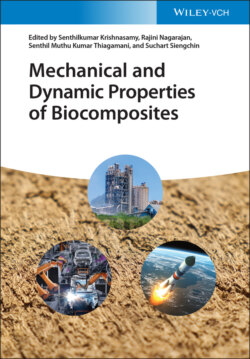Читать книгу Mechanical and Dynamic Properties of Biocomposites - Группа авторов - Страница 29
1.6 Progress and Future Outlooks of Mechanical Behaviors of Natural FRP Hybrid Composites
ОглавлениеApplication of various hybrid natural FRP composites is increasing with their innovative designs and developments through optimized manufacturing techniques. The advent of automation and robots in manufacturing of hybrid natural FRP composite materials has been improving their properties. This will increase in the next century, with synergy of sophisticated processes and techniques. Mechanical properties are most important responses that require serious attention during the design and fabrication of new hybrid natural FRP composites. Other properties of hybrid natural FRP composites, such as thermal, acoustic, electrical, water absorption, among others, are directly dependent on the mechanical behaviors.
The prospect for FRP composite materials is very high and bright. It is presumed that in the next decade, application of various hybrid natural FRP composite materials would have penetrated all facets of life. This will be made possible through enhanced mechanical behaviors of a new set of composites as fiber selection, extraction, treatment, interfacial adhesion with matrix, and processing of natural FRP composite are improved [6].
In addition, there have been significant developments in natural FRP hybrid composites in the past few decades, due to established advantages in terms of processing, low cost, biodegradability, renewability, high specific strength, sustainability, as well as low relative density. Various natural fiber types have been and are being studied, with the findings forming the basis for replacing synthetic fibers, including both carbon and glass. Primarily, the idea of biocomposites development centers around the generation of novel FRP composites that are environmentally friendly with respect to how they are produced, used, and discarded. Hence, natural FRP composites could be a valid replacement and even superior alternative to synthetic fiber composites. Their biodegradable nature offers a good solution to the problem of waste disposal often experienced with synthetic fiber, petroleum, or non‐renewable polymer‐based materials. The application of biocomposites is widening continually and is projected to expand more, with more effects in Europe, due to mounting legislative and public pressures.
Till now, adhesion between the natural reinforcements/fiber and matrix interface, as hybridization increases, remains a major object of concern in terms of overall performance of natural FRP hybrid composites. This is a major factor in the ultimate properties, especially mechanical responses of the biocomposites. Further cutting‐edge research is therefore necessary in order to overcome this challenge. Also, there is a requirement for more research work in order to get over other challenges such as inadequate toughness, moisture absorption, and stability reduction in long‐term outdoor applications. Particularly, various weather conditions, humidity, temperature, and ultraviolet radiation, have significant influence on the product service life of natural FRP hybrid composites. For example, ultraviolet exposure results in discoloring, property deterioration, and deformation.
c Lastly, identifying better extraction of raw materials, sustaining crop growth, product design, and manufacture are activities that will help to reach the goal of better natural FRP hybrid composites. Hence, further research is ongoing across the globe to overcome the aforementioned challenges of biocomposites. Their respective properties should form the basis for generating new applications and create more opportunities for these biocomposites in the present‐day green environment and secured future.
